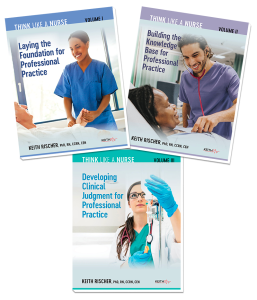
How you define essential nurse thinking terms such as critical thinking, clinical reasoning, and clinical judgment will influence how successfully you are able to teach them to your students.
Equation for Safe Practice
In her textbook on clinical reasoning, Rosalinda Alfaro-LeFevre has a very simple equation that is relevant for every nurse educator:
Critical thinking + clinical reasoning = outcome of a correct clinical judgment
When a nurse can both critically think and clinically reason, that results in a correct clinical judgment as an outcome. The new NCSBN model of clinical judgment that is the basis of the next-generation NCLEX defines clinical judgment as an outcome.
The implication for educators is that you cannot directly teach clinical judgment.
Students must be able to first critically think and clinically reason. The correct clinical judgment follows when critical thinking and clinical reasoning are working together.
Now let’s define what these terms mean to put it all together.
Critical Thinking
Critical thinking has over 60 definitions and some of them are not especially helpful, such as “thinking about your thinking while you’re thinking,” especially when you try to explain this to nursing students!
Fundamentals of Nursing includes a very practical definition of critical thinking:
Critical thinking is the ability of the nurse to think clearly, precisely, and accurately and to act on what you know and understand (Potter and Perry, 2012).
That is why too much information and infobesity need to go once and for all. When a student has superficial knowledge of too much information, they are unable to use and apply this content where it matters most – at the bedside.
Students must understand what is taught before it can be applied. Understanding essential knowledge begins in your classroom!
Clinical Reasoning
Though there are too many nursing definitions for these essential terms that are interrelated, yet distinct, from my lens of clinical practice, the best definition of clinical reasoning can be found in the work of the pre-eminent nurse educator and scholar of our generation, Dr. Patricia Benner, R.N., Ph.D., FAAN, FRCN.
Though widely known for her novice to expert theory, Dr. Benner has written extensively on clinical reasoning and its importance to safe practice.
Two books I highly recommend are Educating Nurses: A Call for Radical Transformation (2010) and Clinical Wisdom and Interventions in Acute and Critical Care: A Thinking In Action Approach (2011).
To maximize the effectiveness of teaching clinical reasoning, you need a definition that captures its essence and can be readily grasped by novice students so they can use and apply it to the bedside.
The following is what I consider the “gold standard” of clinical reasoning derived from Dr. Benner’s work:
- Clinical reasoning is the ability of the nurse to think in action and reason as a situation changes over time by capturing and understanding the significance of clinical trajectories and grasping the essence of the current clinical situation (Benner, Sutphen, Leonard, & Day, 2010).
- The nurse must be able to focus and filter clinical data in order to recognize what is most and least important so the nurse can identify if an actual problem is present (Benner, Hooper-Kyriakidis, & Stannard, 2011).
One of the key components of clinical reasoning is the ability of the nurse to recognize data collected that is clinically significant or most important.
To notice or recognize what clinical data is most important, students must have a deep understanding of pathophysiology applied to the bedside. Do all that you can to ensure that patho is integrated at every level to ensure this needed salience.
Bring it to the Bedside, Step-by-Step
The essence of clinical reasoning derived from Benner’s work is that the nurse must be able to do the following in the clinical setting in order to think like a nurse:
- Think in action and reason as a situation changes.
- Recognize what clinical data is most important.
- Trend all clinical data and recognize the significance of concerning trends.
- Grasp the essence of the current situation.
- Determine if a problem is present.
Patricia Benner’s Novice to Expert theory of professional development identified that novice to advanced beginner nurses struggle to identify care priorities and what is relevant (Benner, 1982).
Applying and integrating Benner’s definition of clinical reasoning will not only prepare students to think like a nurse but will strengthen their professional development as a nurse as well.
Closing the Education/Practice Gap
The strength of Benner’s definition of clinical reasoning is that practicing nurses readily recognize that she has captured the essence of how a nurse thinks to set care priorities and recognize the need to “rescue” if a problem is identified at the bedside. Integrating and emphasizing clinical reasoning is the first step to bridging the current education practice gap in academia.
The goal of every clinical educator must be to integrate Benner’s definition to guide and develop nurse thinking. Though first-year novice students will be a work in progress in seeing all aspects of clinical reasoning incorporated in their practice, the goal for LPN & first-year students should be to recognize what clinical data is most important and then trend it!
By the time a student graduates, the essence of all components (5 steps) of clinical reasoning must be understood and integrated at a basic level so that they will be safe in practice as independent practicing nurses.
In Closing
In Educating Nurses, Benner makes it clear that in order to transform nursing education, clinical reasoning needs to be emphasized. If clinical reasoning is emphasized, then something else needs to be de-emphasized and ultimately removed.
From my vantage point, a three-part NANDA nursing diagnostic statement and lengthy written care plans are the first place to start!
Thanks to Benner’s ongoing contributions to our profession, educators have a practical working definition of clinical reasoning to bring needed change and transformation.
Let’s begin today to incorporate and emphasize this definition of clinical reasoning to prepare students not only for the NCLEX®, but more importantly the reality and rigors of professional practice to positively impact patient outcomes!
Author’s Addendum
I am looking forward to building on this foundational content when I present at the NCSBN NCLEX Virtual Conference on September 22.
I hope you will join me as I share practical strategies to transform classroom instruction to better prepare students for practice and the upcoming Next Generation NCLEX!
Here is the link to register. I hope to connect with you then!
References
- Alfaro-LeFevre, R. (2017). Critical thinking, clinical reasoning, and clinical judgment: A practical approach. (6th ed.). St. Louis, MO: Elsevier–Saunders.
- Benner, P. (1982). From novice to expert. American Journal of Nursing, 82(3), 402–407.
- Benner, P., Sutphen, M., Leonard, V., & Day, L. (2010). Educating nurses: A call for radical transformation. San Francisco, CA: Jossey-Bass.
- Benner, P., Hooper-Kyriakidis, P., & Stannard, D. (2011). Clinical wisdom and interventions in acute and critical care: A thinking-in-action approach. (2nd ed.). New York, NY: Springer.
- Potter, P. A., & Perry, A. G. (2012). Fundamentals of nursing. (8th ed.). St. Louis, MO: Mosby–Elsevier.
Student Resource to Develop Clinical Judgment
To help students understand the clinical reasoning skills that I shared in this article, I recognized the need to create a student-centric resource that would help translate the essence of holistic clinical judgment to the next generation of professional nurses.
 Each volume captures the essence of the three components needed to develop the holistic clinical judgment that will prepare students for professional practice.
Each volume captures the essence of the three components needed to develop the holistic clinical judgment that will prepare students for professional practice.
- Volume 1: Laying the Foundation for Professional Practice (student success/caring/professional formation)
- Volume 2: Building the Knowledge Base of Professional Practice (application of pharm/patho/F&E)
- Volume 3: Developing the Clinical Judgment for Professional Practice (Clinical judgment skills/transition to practice)
These volumes are available for purchase individually or as a bundle of all three. Reach out if you have questions or would like to consider course adoption in your program.
Curriculum Integration Map
Download a curriculum integration map to identify specific chapters in each volume that would provide a practice-based perspective on essential content/knowledge.
Keith Rischer – Ph.D., RN, CCRN, CEN
As a nurse with over 35 years of experience who remained in practice as an educator, I’ve witnessed the gap between how nursing is taught and how it is practiced, and I decided to do something about it! Read more…
The Ultimate Solution to Develop Clinical Judgment Skills
KeithRN’s Think Like a Nurse Membership
Access exclusive active learning resources for faculty and students, including KeithRN Case Studies, making it your go-to resource.




Keith Rischer, RN has his head wrapped around critical thinking and how to teach students this process. Faculty would serve themselves well by reviewing his work and mimicking his model to teach critical thinking which leads to clinical reasoning for nursing students. This will better serve our communities when our students graduate. Most nursing educators are familiar with Benner’s work which appears to be a guiding force, but I also see Tanner’s Clinical Judgment model throughout his philosophy. I am working on adoption of Volume I of his new series to utilize in an introductory course prior to students being selected into the nursing program at our school.